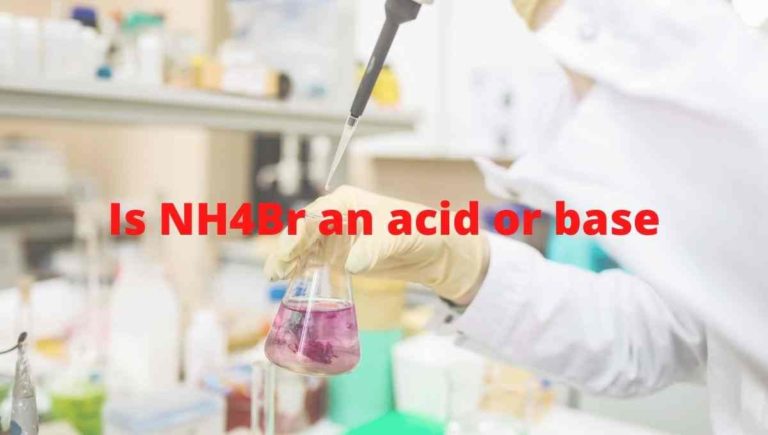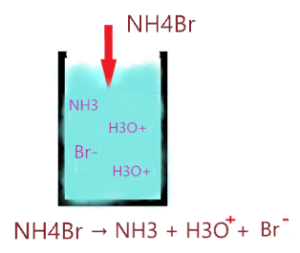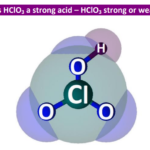Is Ammonium bromide (NH4Br) an acid or base or neutral?

Ammonium bromide is also known as the salt of ammonia and hydrogen bromide is an inorganic compound that appears as a white crystalline solid having the chemical formula NH4Br. It is easily soluble in water and is mainly used for photography in films.
In this article, we will discuss Is ammonium bromide (NH4Br) is an acid or base, or neutral salt in nature?
So, Is NH4Br an acid or base? NH4Br is an acidic salt. It is formed from the neutralization of strong acid, namely Hydrobromic acid (HBr) with a weak base, namely Ammonium hydroxide (NH4OH). The aqueous solution of ammonium bromide (NH4Br) is slightly acidic, having a pH value of less than 7.
| Name of Molecule | Ammonium bromide |
| Chemical formula | NH4Br |
| Molar mass | 97.94 g·mol−1 |
| pH value | <7 |
| Nature | Acidic salt |
Why NH4Br acts as acidic salt?
As we know, NH4Br is a salt of a weak base(NH4OH) and strong acid(HBr). According to the concept of salt, when a neutralization reaction carries out between a strong base and weak acid then the salt is formed which is called a basic salt. Examples of basic salt – Na2CO3, NaF, NaCN, Soap, etc.
Also Read:-
And when neutralization reaction carries out between a weak base and strong acid then the salt is formed which is called acidic salt. Examples – NH4NO3, NH4Cl, etc.
Also Read:-
Therefore, we can say the salt generated from the neutralization reaction is dependent on the strength of the acid base in the reaction.
A stronger base + weak acid will acquire more properties of base instead of acid in solution and a stronger acid + weak base will acquire more properties of acid instead of the base in solution.
⇒ Strong base + Weak acid = Basic solution
⇒ Stronger acid + Weak base = Acidic solution
So, in the case of ammonium bromide, a neutralization reaction happens between the weak base (NH4OH) and strong acid(HBr) so, it will make an acidic salt.

What makes the aqueous solution of NH4Br acidic?
An aqueous solution of NH4Br has an acidic property with a pH value of less than 7. But what’s the reason for this other than the neutralization concept of stronger acid and base.
When NH4Br goes through the hydrolysis process, it split into two ions (NH4+ + Br–).
⇒ NH4Br + H2O → NH4+ + Br–
NH4+ also called ammonium ion is the conjugate acid of ammonia and bromide ion(Br–) is a conjugate base of hydrogen bromide.
Here’s the concept of strong and weak conjugate base/acid:-
- A very strong acid always forms a weak conjugate base.
- A very strong base always forms a weak conjugate acid.
- A very weak acid always forms a strong conjugate base.
- A very weak base always forms a strong conjugate acid.
Note: The conjugate acid from the strong base and conjugate base from the strong acid can never function as acid and base, since, they are too weak to either react with H+ and OH– ions in water solution. Hence, doesn’t affect the pH of the solution.
So, when NH4Br is added to water, it generates two ions ammonium ion(NH4+) and a bromide ion(Br-).
⇒ NH4Br → NH4+ + Br–
Br– is a very weak conjugate base of HBr (a strong acid), hence, it will not undergo hydrolysis in water and doesn’t affect the pH of the solution. You can even neglect the presence of Br– in the solution since it failed to function as a base.
Whereas NH4+ is the conjugate acid of NH3(a weak base) that gets hydrolysis in water to form NH3, leaving H3O+ or H+ ions that make the solution acidic.
NH4+ undergoes a hydrolysis process.

As you see in the above reaction, NH4+ donates the proton to the water molecule and forms the H3O+ or H+ ion. The presence of an H+ ion makes the solution slightly acidic. Here’s what Arrhenius said for acid-
Arrhenius’s theory for acid:
According to this, a compound is an acid when it gives H+ ion after dissolving in an aqueous solution or increases the amount of hydrogen ion in the solution.
So, the Ammonium ion(NH4+) undergoes a hydrolysis process and furnishes the protons in water solution, hence, increasing the number of hydrogen ions or H3O+ ions in a solution which ultimately makes the solution acidic or we can say the aqueous solution of ammonium bromide(NH4Br) is acidic due to hydrolysis of NH4+.
⇒ NH4Br → NH4+ + Br–
⇒ NH4+ + H2O → NH3 + H3O+
⇒ NH4Br → NH3 + H3O+ + Br–
∴ The presence of H3O+ ion in the aqueous solution of NH4Br makes it acidic in nature.
Also read:–
Why NH4Br not a base or basic salt?
A base is defined as the proton acceptor having a pH value range from 8 to 14.
Two theories that explain what is base in chemistry:-
(1). Arrhenius theory for base:
According to the Arrhenius concept, the compound is said to be base when it produces OH- ion through ionization or through dissociation in water.
(2). Bronsted-Lowry concept:
According to the Bronsted-Lowry concept, a compound is said to be base when it accepts the proton from other compounds.
So, NH4Br is not a base because it doesn’t satisfy any of these theories. As when NH4Br is dissolved in an aqueous solution it produces an H+ ion with the help of hydrolysis of NH4+, this makes the solution acidic as there is no OH– ion present in the final solution after dissociation of NH4Br.

As per Bronsted-Lowry theory, NH4Br is also not a base because its NH4+ ion is the conjugate acid of a weak base (NH3) that doesn’t accept the proton from another species or compound. So, the ion of NH4Br behaves as a proton donor rather than a proton acceptor.
Also, NH4Br is not a basic salt because it is formed from the combination of strong acid and weak bases that always produce acidic salt.
The concept of acidic salt and basic salt:-
⇒ Strong base + Weak acid = Basic salt
⇒ Stronger acid + Weak base = Acidic salt
Also Check:
Properties of Ammonium bromide
- It has a molar mass of 97.94 g·mol−1.
- It appears as a white powder.
- It is easily soluble in water.
- It has a boiling point of 452 °C and a melting point of 235 °C.
- It has a pH value of less than 7.
- Uses of Ammonium bromide
- It is used to fireproof wooden elements.
- It is used to control fungi, algae, and bacteria in the wastewater management industry.
- It is also used in pharmaceutical preparations.
- It is used in lithography and process engraving.
Summary
“Ammonium bromide is an ammonium salt composed of ammonium and bromide ions in a 1:1 ratio. It is an ammonium salt and a bromide salt.”. Let’s cover the important point we discussed in this article on whether NH4Br is an acid or base.
- Is NH4Br acidic or basic salt? NH4Br is slightly acidic. It is made from the neutralization reaction of strong acid, namely hydrobromic acid (HBr), and weak base, namely ammonium hydroxide (NH4OH).
- The aqueous solution of NH4Br is acidic. Because of the presence of H+ ions or H3O+ ions generated from the hydrolysis of NH4+.
- When NH4Br dissolved in an aqueous solution it split into NH4+ and Br–. The ammonium ion is the conjugate acid of the weak base that can donate the proton to the water molecule and produces H+ ions in the solution that makes the aqueous solution of NH4Br slightly acidic.
About the author
Vishal Goyal is the founder of Topblogtenz, a comprehensive resource for students seeking guidance and support in their chemistry studies. He holds a degree in B.Tech (Chemical Engineering) and has four years of experience as a chemistry tutor. The team at Topblogtenz includes experts like experienced researchers, professors, and educators, with the goal of making complex subjects like chemistry accessible and understandable for all. A passion for sharing knowledge and a love for chemistry and science drives the team behind the website. Let's connect through LinkedIn: https://www.linkedin.com/in/vishal-goyal-2926a122b/

